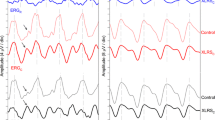Abstract
We examined the on- and off-responses of the photopic electroretinogram in patients with complete congenital stationary night blindness. Standard flash electroretinograms as well as those produced in a ganzfeld modified for long-duration light stimuli (500 msec) permitted the separation of on- and off-responses in four patients and four normal subjects. The amplitude and latency of the electroretinogram on- response (a- and b-waves) and off-response (d-wave) in addition to the oscillatory potentials of the off-response in normal subjects and patients were compared. The abnormal on-response was demonstrated in all the patients, and the offresponse with its oscillatory potentials were preserved. We showed that the second portion of the off-response (of inner retinal origin) is normal. If congenital stationary night blindness is a defect of depolarizing bipolar cells, these results preclude input of the depolarizing bipolar cells and support the hyperpolarizing bipolar cells as the cellular origin of the off-response electroretinogram.
Similar content being viewed by others
Abbreviations
- CSNB:
-
congenital stationary night blindness
- DBC:
-
depolarizing bipolar cell
- HBC:
-
hyperpolarizing bipolar cells
References
Carr RE. Congenital stationary night blindness. In: Heckenlively, JR, Arden GB, eds. Principles and practice of clinical electrophysiology of vision. St. Louis, MO: C.V. Mosby, 1991: 713–20.
Miyake Y, Yagasaki K, Horiguchi M, Kawase Y. On- and off-responses in photopic electroretinogram in complete and incomplete types of congenital stationary night blindness. Jpn J Ophthalmol 1987; 31: 81.
Alexander KR, Fishman GA, Peachey NS, Marchese AL, Tso MOM. “On” response defect in paraneoplastic night blindness with cutaneous malignant inelanoma. Invest Ophthalmol Vis Sci 1992; 33: 477–83.
Heckenlively JR, Martin DA, Rosenbaum AL. Loss of electroretinographic oscillatory potentials, optic atrophy and dysplasia in congenital stationary night blindness. Am J Ophthalmol 1983; 96: 526–34.
Nagata M. Studies on the photopic ERG of the human retina. Jpn J Ophthalmol 1963; 7: 96–124.
Krill AE, Martin D. Photopic abnormalities in congenital stationary night blindness. Invest Ophthalmol Vis Sci 1971; 10: 625.
Hill DA, Arbel KF, Berson EI. Cone electroretinograms in congenital nyctalopia with myopia. Am J Ophthalmol 1974; 78: 127.
Lachapelle P, Little J, Polomeno RC. The photopic electroretinogram in congenital stationary night blindness with myopia. Invest Ophthalmol Vis Sci 1993; 24: 442.
Siegel IM, Greenstein VC, Seiple WH, Carr RF. Cone function in congenital nyctalopia. Doc Ophthalmal 1987; 65: 307.
Young RSL. Low-frequency component of the photopic ERG in patients with X-linked congenital stationary night blindness. Clin Vis Sci 1991; 6: 309.
Houchin KW, Purple RL, Wirtschafter JD. X-linked congenital stationary night blindness and depolarizing bipolar system function. Invest Ophthalmol Vis Sci 1991: 32 (suppl): 1229.
Frishman LJ, Karwoski C. The d-wave. In: Heckenlively JR, Arden GB, eds., Principles and practice of clinical electrophysiology of vision. St. Louis, MO: C. V. Mosby, 1991: 112–4.
Stockton RA, Slaughter MM. B-wave of the electroretinogram: a reflection of on bipolar cell activity. J Gen Physiol 1989; 93: 101–22.
Brown KT. The electroretinogram: its components and their origin. Vision Res 1968; 8: 633–77.
Daw NW, Jensen RJ, Brunken WJ. Rod pathways in mammalian retinae. Trends Neurosci 1990; 13: 110.
Murayama K, Sieving PA. Different rates of growth of monkey and human photopic a-, b-, and d-waves suggest two sites of ERG light adaptation. Clin Vision Sci 1992; 7: 385–92.
Sieving PA, Murayama K, Naarendorp F. Push-pull model of the primate photopic electroretinogram: a role for hyperpolarizing neurons in shaping the b-wave. Vis Neurosci 1994; 11: 519–32.
Author information
Authors and Affiliations
Rights and permissions
About this article
Cite this article
Quigley, M., Roy, MS., Barsoum-Homsy, M. et al. On- and off-responses in the photopic electroretinogram in complete-type congenital stationary night blindness. Doc Ophthalmol 92, 159–165 (1996). https://doi.org/10.1007/BF02583287
Accepted:
Issue Date:
DOI: https://doi.org/10.1007/BF02583287




